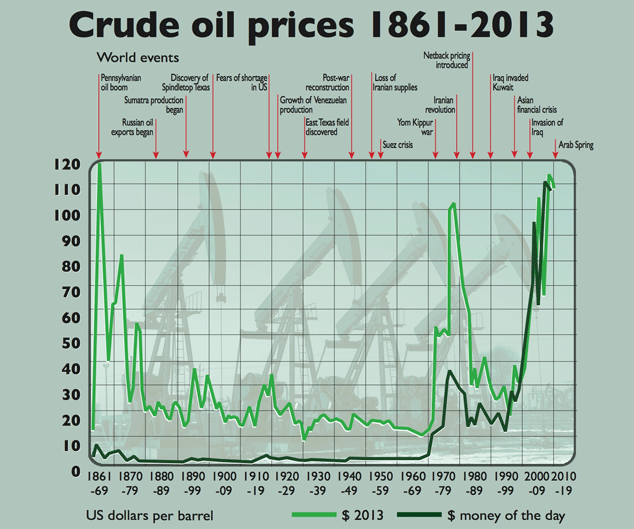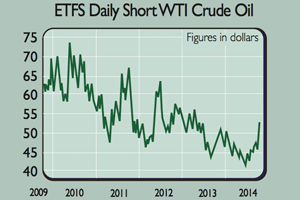Profit as oil hits the skids
The oil price is stuck in a downward trend. That may be bad for oil producers, but it’s good for consumer economies like ours, says John Stepek.


The oil price is stuck in a downward trend. That may be bad for oil producers, but it's good for consumer economies like ours, says John Stepek.
The last decade has been a fantastic time to be an oil producer perhaps the best time period in the modern age. The price of Brent crude has averaged around $103 a barrel since 2010, and traded in a range between around $100 and $120.
To see just how expensive this is, take a look at the chart below, from the 2014 BP Statistical Review of World Energy.
MoneyWeek
Subscribe to MoneyWeek today and get your first six magazine issues absolutely FREE

Sign up to Money Morning
Don't miss the latest investment and personal finances news, market analysis, plus money-saving tips with our free twice-daily newsletter
Don't miss the latest investment and personal finances news, market analysis, plus money-saving tips with our free twice-daily newsletter
It shows the price of oil going all the way back to 1861, adjusted to 2013 prices. As you can see, bar the dawn of the oil era, the price has never been higher including during the 1970s oil embargo by the Opec oil cartel. But in the last few months, the oil price has dived.
Brent crude is now in a bear market (in other words, it's dropped by more than 20% from its high point). That's surprised most oil analysts. The conventional wisdom was that oil would be propped up around the $100 mark primarily because if all else failed Saudi Arabia and Opec "wouldn't allow" prices to fall that far. So what's going on?
As with the price of anything, this is all about supply and demand and neither looks promising for oil. On the demand side, the global economy looks wobbly. China a big source of demand is slowing, while Europe, led by Germany, seems to be sliding back into recession.
This week the International Energy Agency slashed its forecast for demand growth in 2015. It sees demand growing by 1.1 million barrels a day (mbd), rather than 1.4 million.
But really, it's the supply side we should look to. There have been minor surprises such as Libyan production beating expectations. But the big shift is a story we've already heard a lot about the shale revolution'. Developments in hydraulic fracturing (fracking') have revitalised American oil production.
In 2011, US crude output stood at 5.7 mbd. Last week it touched 8.8 million barrels, the highest since March 1986, according to the US Energy Information Administration. To put that into perspective, on some measures (if you include natural gas liquids) the US has overtaken Saudi Arabia as the world's biggest liquid petroleum producer.
The US isn't widely exporting this oil yet but it does mean that America's requirement for imported oil has slid.

An oil price war
How have the Saudis reacted? One of their partners in Opec, Venezuela, is panicking calling for production cuts to keep the price at $100. But according to Reuters, Saudi Arabia "is quietly telling the oil market it would be comfortable with much lower oil prices for an extended period perhaps down to $80, for as long as a year or two".
Why would the Saudis put up with a lower oil price? There are a few good reasons. Firstly, they're not stupid. They realise as well as everyone else does that high prices sow the seeds of their own destruction.
US shale only became feasible in the first place because oil prices were so high. And shale is far from the only alternative source that high prices have unleashed everything from deepwater, to the tar sands, to proposals for drilling at the poles only makes sense with soaring oil prices.
The rise of the electric car almost certainly wouldn't have been possible either. So the Saudis don't want to kill the golden goose.
Secondly, there's the question of maintaining a customer base. As energy economist Philip Verleger tells John Kingston of Platts, "Saudi officials may be particularly concerned with the situation in Asia, where they confront heightened competition due to supply increases from west Africa, Russia and even Alaska".
Last month, the US sent Alaskan crude oil off to South Korea. It was the first such export in over a decade, and it's unlikely to be the last. That's at least one reason why both Saudi and Iran (the second-biggest Opec producer) are now selling their crude to Asia at the biggest discounts since shortly after the 2008 financial crisis.
As Carsten Fritsch of Commerzbank put it, "Opec countries appear to be more interested in defending their market shares at present than stabilising prices".
Opec may be a cartel, but its members' historical record of co-operating with one another is patchy at best and in an environment of falling rather than rising prices, it's easy for gentlemen's agreements to go out of the window. So all eyes will be on Opec's next meeting at the end of November, to see if cartel-wide production cuts can be agreed.
But Ali al-Omair, Kuwait's oil minister, has already described cuts as being pointless, given rising Russian and US production. He argued that prices are likely to stop falling at around $76 to $77 a barrel, as that would put a stop to many marginal projects.
In any case, this sort of speculation over the likelihood or otherwise of cuts' probably credits Opec with too much influence. As John Kemp notes on Reuters, "there is no evidence that Saudi Arabia, or Opec, has had a decisive impact on medium and long-termprice trends".
Yes, Opec can "slow the rate at which prices move". But other than the late 1970s and the oil embargo, the major trends in oil prices have been driven by developments in other areas, such as the discovery of North Sea oil, or US shale.
"If Saudi Arabia, with or without Opec support, cut its ownoutput in a bid to keep prices high, it would be buying a temporary reprieve on prices but only at the expense of market share. With the shale boom continuing, and demand stagnant, any reprieve could only be temporary."
Instead, says Kemp, the only realistic strategy is to "allow prices to fall until the market rebalances naturally, with slower growth in shale and bigger increases in demand".
But how long might that take? Clearly a sliding oil price is not good news for producers of any sort of exotic' oil.The oil majors are already struggling with overspending and cost control.
According to The Economist, consultancy EY reckons that there are currently 163 megaprojects' costing more than $1bn each being funded by oil majors. Spending has been rising more rapidly than revenues, and most of these projects are already "over budget and behind schedule".
Worse still, most were also planned based on a $100 a barrel oil price being in place for years. Already, projects in harder-to-reach places such as the Arctic and technically challenging deepwater fields are being cut back or cancelled. The likes of Shell and ExxonMobil are reducing capital spending and trying to sell assets.
Yet it could take some time for this to have an impact on the oil price. For example, the International Energy Agency reckons that only around 4% of shale oil production has a breakeven' price of more than $80 a barrel. In some US oil fields, prices could fall much farther before they become uneconomic.
As Seth Kleinman of Citigroup points out, for those frackers' who have already invested in setting up rigs, and possibly even hedging crude prices, the cost at which they would have to shut down production is far lower than $80 a barrel Kleinman reckons it's more like $37-$45 a barrel.
On top of that, the breakeven price is continually "falling as technology refinements improve economics". As a result, "the floor is falling and may not be nearly as firm as the Saudi view assumes... even at $75 a barrel or perhaps below, US oil production would almost certainly grow in 2015 and 2016".
America's not-so-secret weapon
The final point is that whatever Opec might hope, America is not going togive up its energy advantage. One idea that has been floating around is thatthere is some sort of geopolitical pact between Saudi Arabia and the US to knock oil prices down in order toscupper the likes of Russia and Iran.
This seems a little far-fetched although it's worth noting that the vice-president of Russian state-owned oil giant Rosneft this week said that Saudi Arabia was manipulating the oil price, and that Saudi in turn was "being manipulated, which could end badly".
Whatever the truth on that front, there's no doubt that the US prizes its new-found energy independence. Back in 2011, Thomas Donilon, then US national security adviser, said: "America's new energy posture allows us to engage from a position of greater strength. Increasing US energy supplies act as a cushion that helps reduce our vulnerability to global supply disruptions and price shocks. It also affords us a stronger hand in pursuing and implementing our national security goals."
As Aly-Khan Satchu puts it in Kenyan newspaper The Star, America has become "the new price setter for the oil markets". The "biggest losers" from this include Vladimir Putin's Russia, which needs oil prices to average around $100 a barrel to cover the government's spending commitments.
So even if lower prices look like causing trouble for the fracking business at some point, it's hard to believe that the US government would allow the industry to collapse without putting up some sort of fight.
There's certainly a risk that fracking will underwhelm in the longer run no one is quite sure of how sustainable current production rates are but expect the industry to get any backing it needs to keep the boom going.
In short, it looks as though we could be embarking on a lasting and welcome trend of lower oil prices. We look at the best ways to profitbelow.
The impact of cheaper oil
A slide in the oil price is good news for motorists and consumer economies in general. In the UK for example, while the slide in crude oil has been offset to an extent by the pound falling against the dollar, drivers are still enjoying the cheapest petrol prices we've seen in the last three years.
It's also helped that the troubled supermarket sector is engaged in a bitter price war. The AA reckons that a 50-litre tank of unleaded petrol now costs about £2.50 less than it did a year ago, and diesel is a good deal cheaper too.
The immediate reaction has been for pundits to fret about deflation. Already Britain's annual inflation rate (as measured by the consumer price index) has fallen to just 1.2% in September a five-year low helped by a drop in transport costs.
In our debt-burdened world, falling prices terrify economists. Deflation makes debt harder to pay off the cost of debt is usually fixed, so in a deflationary environment the debt grows in real terms.
However, falling oil prices are rather a benign form of deflation, at least for consumer economies like ours. For example, if you don't have to spend as much money on petrol, then you will have more available to spend on other stuff be that paying off debts or, more likely, splashing out on discretionary spending.
Andrew Kenningham of Capital Economics reckons that "a $10 fall in the price of oil" is like transferring "0.5% of world GDP from oil producers to oil consumers". So assuming consumers spend half of these gains, global demand for goods and services would rise by 0.2%-0.3%.
If anything, in the longer run, cheaper oil prices could even be inflationary. That's partly because they will help to boost consumer demand. But it also gives the Bank of England all the statistical excuses it needs to keep interest rates at their current levels until at least after the general election in May 2015. And the longer rates stay low, the more likely inflation is to run ahead of the Bank's 2% target in the longer run.
The 13 investments to buy now
The most obvious way to profit from a falling oil price is to short-sell oil. Short-selling is always risky, and if you plan to do it with leverage (by spread betting, for example) then you have to be extremely careful the oil price can be volatile, and it's very easy to get wiped out, even when you're betting in the right direction.

A safer if still relatively risky option is to buy an exchange-traded fund (ETF) that will rise as the oil price falls. ETFS Daily Short WTI Crude Oil (LSE: SOIL), which tracks the WTI benchmark (rather than Brent), has done its job well during past periods of falling oil prices. Just remember to keep an eye on the trade this isn't buy and hold' forever territory and get out when it looks as though a bottom has been reached.
In terms of individual countries, two stand out as big beneficiaries from falling oil prices India and Japan. The sliding oil price is making life easier for the new Indian prime minister, Narendra Modi, by allowing him to cut fuel subsidies and therefore the country's deficit without inflicting too much obvious pain on the population the country imports around 75% of its oil.
Meanwhile, despite the tumbling yen, Japan's oil import bill is going down as Bank of Japan governor Haruhiko Kuroda noted recently, "a decline in oil prices itself is a plus for the economy", even if it means the headline inflation figures end up being a little lower than he'd like in the short term.
You can access India via Aberdeen's New India Investment Trust (LSE: NII) and Japan via the Baillie Gifford Japan Trust (LSE: BGFD), or use the iShares MSCI Japan GBP Hedged ETF (LSE: IJPH) to bet on a falling yen too.
On the flip side, Russia will be hit hard by falling oil. The market is dirt cheap, but if you decide to take a punt on it, it really is a punt there's no guarantee things will get better.
Consumer-dependent stocks should benefit from a falling oil price, particularly if the US economy continues to recover. Petrol accounts for about 11% of American discretionary household spending, according to MarketWatch. So a falling oil price translates into significant savings.
"That money is going to be moving into cash registers" this autumn, says David Rosenberg of Gluskin Sheff. "Cheap gasoline acts like a tax cut that will flow through the US economy in a big way. This couldn't have come at a better time."
It's a similar story (slightly lessened by tax differences between countries) in developed nations across the world. Goldman Sachs reckons that, judging by past periods of falling oil prices, consumer-staple stocks tend to beat the market, so you could look at the producers of big consumer brands names like Nestl (Zurich: NESN), Unilever (LSE: ULVR) or Reckitt Benckiser (LSE: RB).
Transport stocks should also welcome a lower oil price. Consumers will have more money to spend on holidays and it'll cost less to get them there. That's good for the airline easyJet (LSE: EZJ), which yields around 2.5%; cruise operator Carnival (LSE: CCL),which yields about 3%; and tour operators such as Thomas Cook (LSE: TCG).
Logistics firms such as United Parcel (NYSE: UPS) and FedEx (NYSE: FDX) should benefit for similar reasons. On the oil production side, it's hard to be bullish on oil producers, who will find that life gets a lot trickier.
But one interesting play could be to buy suppliers of fracking sand. Some drillers have found that using sand when fracking boosts output from wells. As a result, demand is surging. One of the biggest players is US Silica Holdings (NYSE: SLCA).
Get the latest financial news, insights and expert analysis from our award-winning MoneyWeek team, to help you understand what really matters when it comes to your finances.
John Stepek is a senior reporter at Bloomberg News and a former editor of MoneyWeek magazine. He graduated from Strathclyde University with a degree in psychology in 1996 and has always been fascinated by the gap between the way the market works in theory and the way it works in practice, and by how our deep-rooted instincts work against our best interests as investors.
He started out in journalism by writing articles about the specific business challenges facing family firms. In 2003, he took a job on the finance desk of Teletext, where he spent two years covering the markets and breaking financial news.
His work has been published in Families in Business, Shares magazine, Spear's Magazine, The Sunday Times, and The Spectator among others. He has also appeared as an expert commentator on BBC Radio 4's Today programme, BBC Radio Scotland, Newsnight, Daily Politics and Bloomberg. His first book, on contrarian investing, The Sceptical Investor, was released in March 2019. You can follow John on Twitter at @john_stepek.
-
 The new 4% rule – how much should retirees really draw from their pension in 2026?
The new 4% rule – how much should retirees really draw from their pension in 2026?Brits retiring in 2026 could be withdrawing too much from their pension pots if they stick to an old rule about ‘safe’ limits – with the risk of running out of money in retirement
-
 Leaving it too late to gift inheritances costs some of Britain’s wealthiest families £3m each
Leaving it too late to gift inheritances costs some of Britain’s wealthiest families £3m eachEven average Brits are being landed with huge and unexpected inheritance tax bills because of a little understood rule around gifting, new figures show
-
 Invest in space: the final frontier for investors
Invest in space: the final frontier for investorsCover Story Matthew Partridge takes a look at how to invest in space, and explores the top stocks to buy to build exposure to this rapidly expanding sector.
-
 Invest in Brazil as the country gets set for growth
Invest in Brazil as the country gets set for growthCover Story It’s time to invest in Brazil as the economic powerhouse looks set to profit from the two key trends of the next 20 years: the global energy transition and population growth, says James McKeigue.
-
 5 of the world’s best stocks
5 of the world’s best stocksCover Story Here are five of the world’s best stocks according to Rupert Hargreaves. He believes all of these businesses have unique advantages that will help them grow.
-
 The best British tech stocks from a thriving sector
The best British tech stocks from a thriving sectorCover Story Move over, Silicon Valley. Over the past two decades the UK has become one of the main global hubs for tech start-ups. Matthew Partridge explains why, and highlights the most promising investments.
-
 Could gold be the basis for a new global currency?
Could gold be the basis for a new global currency?Cover Story Gold has always been the most reliable form of money. Now collaboration between China and Russia could lead to a new gold-backed means of exchange – giving prices a big boost, says Dominic Frisby
-
 How to invest in videogames – a Great British success story
How to invest in videogames – a Great British success storyCover Story The pandemic gave the videogame sector a big boost, and that strong growth will endure. Bruce Packard provides an overview of the global outlook and assesses the four key UK-listed gaming firms.
-
 How to invest in smart factories as the “fourth industrial revolution” arrives
How to invest in smart factories as the “fourth industrial revolution” arrivesCover Story Exciting new technologies and trends are coming together to change the face of manufacturing. Matthew Partridge looks at the companies that will drive the fourth industrial revolution.
-
 Why now is a good time to buy diamond miners
Why now is a good time to buy diamond minersCover Story Demand for the gems is set to outstrip supply, making it a good time to buy miners, says David J. Stevenson.
